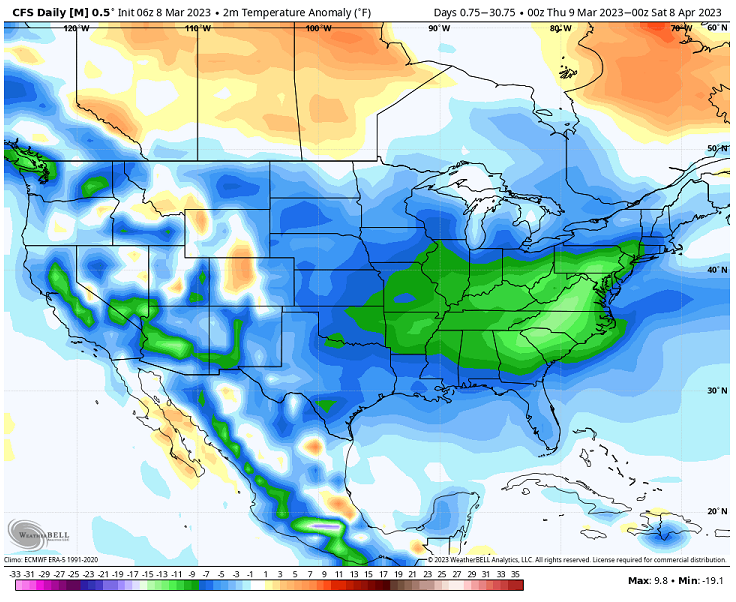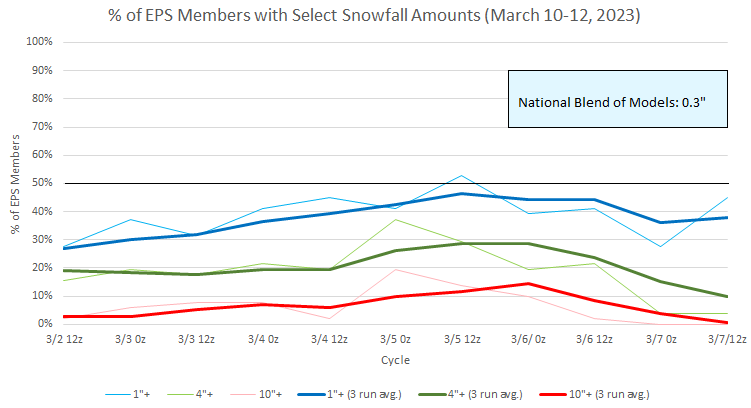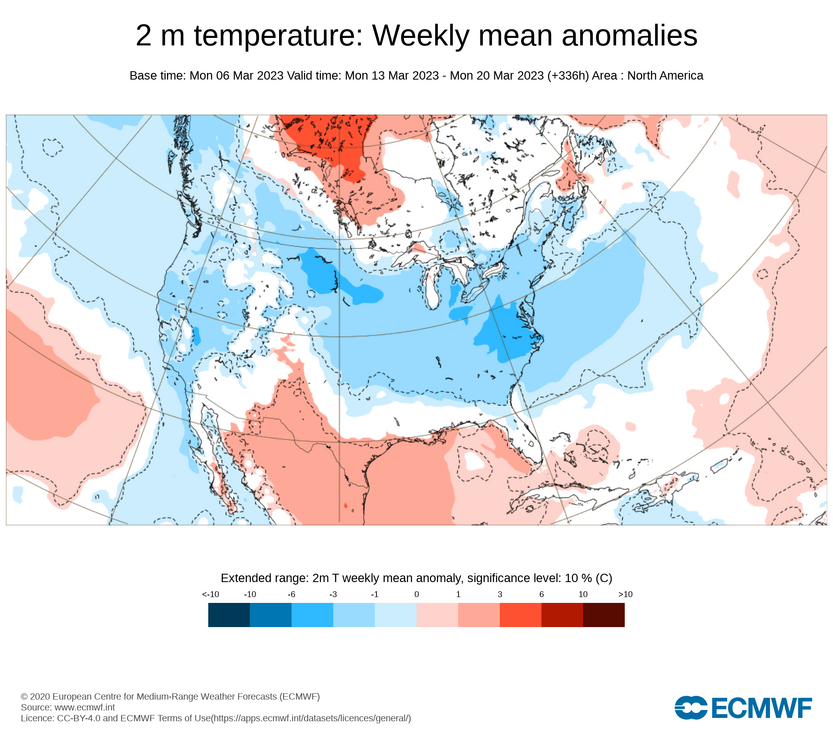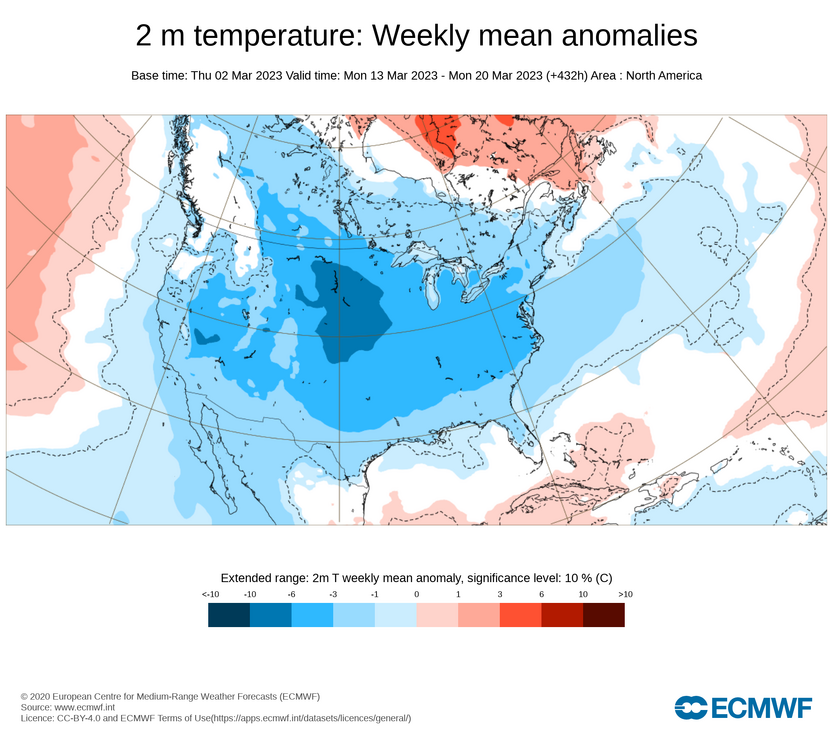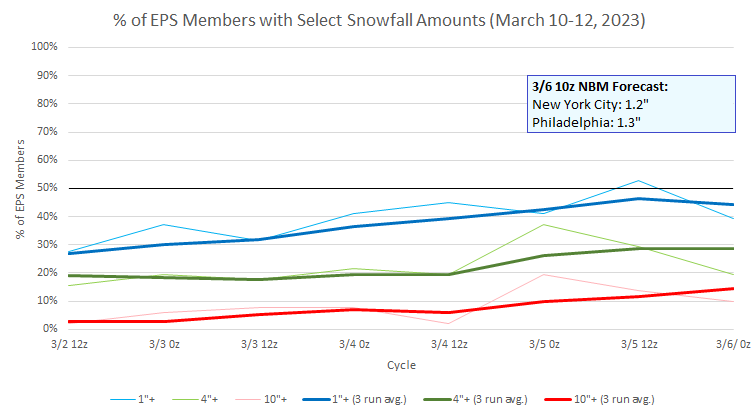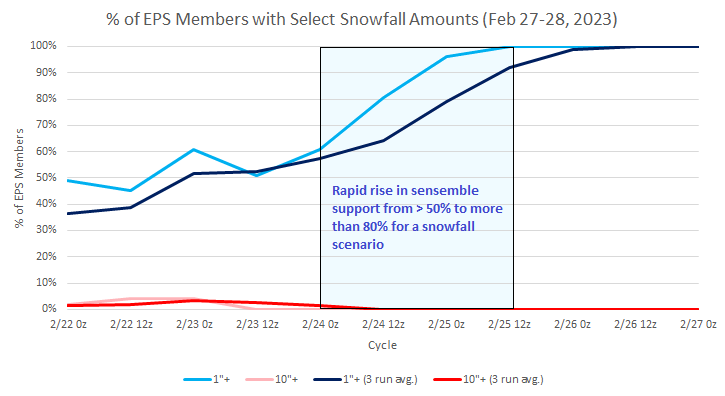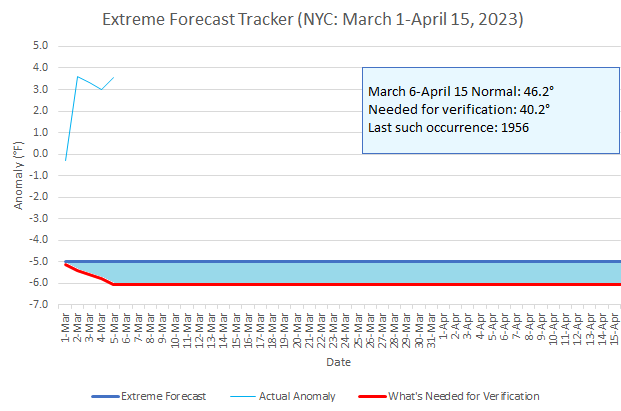-
Posts
22,978 -
Joined
Content Type
Profiles
Blogs
Forums
American Weather
Media Demo
Store
Gallery
Everything posted by donsutherland1
-
Temperatures again rose into the upper 40s and even lower 50s across the Middle Atlantic region. In southern Florida, Miami reached 90° for the third consecutive day. With March 6-8 seeing the temperature reached 90° or above, Miami has set a new record for its earliest heatwave. The previous record of April 8-10 was set in 2020. A colder regime is poised to develop in coming days, even as no severe March cold appears likely. The March 13-20 timeframe could be the month's coldest week with temperatures averaging 4°- 7° below normal for the week. The colder regime will gradually fade afterward, but could persist through the closing week of March. A storm will likely bring rain to the coastal plain on Friday into Satuday. As the storm moves away on Saturday, the rain could end as a period of snow from Philadelphia to New York City. Well north and west of New York City and Newark, 1"-3" of snow could fall. Little or no accumulation currently appears likely in Philadelphia, Newark, and New York City. However, there remains a degree of uncertainty. Another storm could affect the region during the March 13-15 timeframe. Although this storm appears capable of bringing more snow to the region, the coastal plain again risks more rain than snow. There is a larger degree of uncertainty concerning this potential event. The picture should become clearer by the weekend. Historic experience with very low snowfall totals through February argues that a very snowy March or big snowstorm during March or April are unlikely. Despite attractive 500 mb patterns, the base case is that at least through March 10th, snowfall will likely be below normal from Philadelphia to New York City. For further historical perspective, there were 16 winters that had less than 8" of snowfall through February in New York City. Just two (13%) had a 6" or greater snowstorm during March or April: 1889-1890: 6.0" on March 19th and 1991-1992: 6.2" on March 19th. Historical perspective argues for caution when the operational models are popping big snowstorms into and out of existence like quantum particles in the extended range. The ENSO Region 1+2 anomaly was +1.1°C and the Region 3.4 anomaly was -0.2°C for the week centered around March 1. For the past six weeks, the ENSO Region 1+2 anomaly has averaged +0.48°C and the ENSO Region 3.4 anomaly has averaged -0.43°C. La Niña conditions have now given way to neutral ENSO conditions. Neutral ENSO conditions will likely prevail through at least mid-spring. The SOI was +5.31 today. The preliminary Arctic Oscillation (AO) was -2.084 today. On March 6 the MJO was in Phase 7 at an amplitude of 3.658 (RMM). The March 5-adjusted amplitude was 3.286 (RMM). Based on sensitivity analysis applied to the latest guidance, there is an implied 55% probability that New York City will have a colder than normal March (1991-2020 normal). March will likely finish with a mean temperature near 42.0° (0.8° below normal).
-
The below CFSv2 map was posted on Twitter this morning. No commentary about the nature of modeled depiction was included. Thus, it was implied that a month-long period of historic cold for the timeframe is forthcoming. The magnitude of cold shown above has virtually no chance at verifying. Minimal due diligence would have required that one check out the solution to see if it's reasonable before posting it. As an example, I will use Washington, DC and Raleigh. For Washington, DC, the posted map assumes that the March 8-April 7 period would average about 12 degrees below normal. The normal 1991-2020 figure is 49.6°. The map implies a 37.6° average temperature. Washington, DC has never seen such a cold March 8-April 7 period. It has seen just four cases with a mean temperature below 40°: 1885: 38.1° 1887: 39.9° 1896: 39.0° 1906: 39.8° The 1881-1910 normal value for that period was 45.0°. That was more than 4.5° colder than today's normal value. The coldest value over the last 100 years occurred in 1960 with a mean temperature of 41.6°, which is 4° above the implied number on the map. For Raleigh, the map is even more unrealistic. The normal 1991-2020 value is 52.8°. The map implies an anomaly of 14° below normal (38.8° mean temperature). Raleigh's coldest such period was 44.4° in 1915. That's not even remotely in the "ballpark" of the idea shown on the map. All said, the map should not have been posted. It is highly unrealistic. It serves no useful purpose. Given that many Social Media users are unfamiliar with the models, maps, and their limitations, any post of the map should have been accompanied by appropriate disclosure that the cold shown is overdone or some other notice to alert readers to the unrealistic nature of the map. Such maps, exaggerated claims, repeated calls for extremes, among other things, create a perception that meteorologists aren't very good at forecasting--they are "guessing" and little more. In fact, that perception could not be more wrong. Meteorologists are very good. The problem is that skillful forecasts and insightful discussions are drowned out by the noise of unrealistic ideas on Social Media. Perhaps, when deciding what to post, one should keep in mind the AMS's mission statement for guidance, whether one is a professional or not: The American Meteorological Society advances the atmospheric and related sciences, technologies, applications, and services for the benefit of society. Specifically, the posts should be intended for the "benefit of society." Informing society about what to expect, alerting society to emergent risks, and explaining potential impacts all benefit society. Pushing unrealistic solutions without appropriate qualifying language does not.
-
Morning thoughts… It will be partly sunny and cool. High temperatures will reach the middle and upper 40s in most of the region. Likely high temperatures around the region include: New York City (Central Park): 48° Newark: 50° Philadelphia: 49° Somewhat cooler than normal to near seasonable readings will likely prevail through the remainder of the week. Normals: New York City: 30-Year: 47.2°; 15-Year: 47.7° Newark: 30-Year: 48.3°; 15-Year: 49.0° Philadelphia: 30-Year: 50.0°; 15-Year: 50.3°
-
-
A colder regime will very likely commence later this week. At present, no severe March cold appears likely. However, the March 13-20 timeframe could be the month's coldest week with temperatures averaging 4°- 7° below normal for the week. The colder regime will gradually fade afterward, but could persist through the closing week of March. Potential storminess around the March 11-12 timeframe has become less impressive on the ensembles. However, a second potential system has emerged for the March 13-15 timeframe. There is the potential for at least some snowfall in New York City, Newark, and Philadelphia with either potential system. The first will likely be mostly rain for the cities. Uncertainty persists, but the picture should become clearer near or just after midweek for the earlier system and late this week or the weekend for the latter one. Historic experience with very low snowfall totals through February argues that a very snowy March or big snowstorm during March or April are unlikely. Despite attractive 500 mb patterns, the base case is that at least through March 10th, snowfall will likely be below normal from Philadelphia to New York City. For further historical perspective, there were 16 winters that had less than 8" of snowfall through February in New York City. Just two (13%) had a 6" or greater snowstorm during March or April: 1889-1890: 6.0" on March 19th and 1991-1992: 6.2" on March 19th. Historical perspective argues for caution when the operational models are popping big snowstorms into and out of existence like quantum particles in the extended range. The ENSO Region 1+2 anomaly was +1.1°C and the Region 3.4 anomaly was -0.2°C for the week centered around March 1. For the past six weeks, the ENSO Region 1+2 anomaly has averaged +0.48°C and the ENSO Region 3.4 anomaly has averaged -0.43°C. La Niña conditions have now given way to neutral ENSO conditions. Neutral ENSO conditions will likely prevail through at least mid-spring. The SOI was +7.42 today. The preliminary Arctic Oscillation (AO) was -2.487 today. On March 5 the MJO was in Phase 7 at an amplitude of 3.284 (RMM). The March 4-adjusted amplitude was 3.030 (RMM). Based on sensitivity analysis applied to the latest guidance, there is an implied 56% probability that New York City will have a colder than normal March (1991-2020 normal). March will likely finish with a mean temperature near 42.0° (0.8° below normal).
-
Newark: 7.3" for the first storm, 4.1" for the second Mount Pocono: 9.3" for the first storm, 6.8" for the second
-
That was the monthly total. The biggest storm was 6.0”.
-
The 0z ECMWF showed a blockbuster snowfall from eastern Pennsylvania into New England (again). This time, the storm was kicked a few days into the future and was centered around March 14th. In response, 240-hour snow maps are already popping up like mushrooms after a summer thunderstorm on Social Media. Some reminders: 1. Much can change between now and then as the models work through the synoptic details. Almost certainly, there will be some significant changes. 2. Ensemble support is currently modest albeit with a few members showing a major storm (one shows a borderline historic storm). 3. Model consensus does not currently exist and run-to-run continuity has not been established. 4. Historic experience argues for extra caution. Since 1884-85, there were 19 previous winters that saw less than 10" of snow through February in New York City and Philadelphia. None saw a 10" snowstorm in either city during March. Just one saw March come out with 10" or more total snowfall in New York City. Select Data for those Winters: New York City: Mean March Snowfall: 3.5" Median March Snowfall: 2.5" Highest March Snowfall: 17.1", 1890 Philadelphia: Mean March Snowfall: 2.3" Median March Snowfall: 2.1" Highest March Snowfall: 5.8", 1890 and 1932 History is not a guarantee and the sample size is modest. It does provide some insight that asserts the importance of being cautious about jumping prematurely on extended range solutions, especially in a winter that has seen one failure after another in the snowfall department. In addition, the modeled evolution for the March 10-12 timeframe--the ECMWF's most recent try at a big snowstorm--illustrates the need for caution. For several 0z runs, the operational ECMWF had 10" or more snow in both New York City and Philadelphia (peaking at 10" in Philadelphia and 24" in New York City). Run-to-run continuity was very poor with the 12z runs shattering the dreams built from the 0z cycle. The overwhelming share of EPS members were always below 4". That potential event now appears poised to be a mostly rain event. Now, a single run of the ECMWF--again at the seemingly notorious 0z cycle--shows a massive snowstorm for both cities a few days later. Given the four points above, one should wait until there is strong support, model consensus, and good run-to-run continuity. Will this time be different? Perhaps. But a lot more data will be needed. Any firm call at this time is simple speculation in the near-absence of sufficient data. It is a largely-uninformed guess, though Twitter and other Social Media platforms have nothing that distinguishes between an informed assessment and a wild guess. In most cases, such gambles fail, as relying on near random chance to ride to the rescue of a speculative guess in the absence of underlying support is typically futile.
-
Not all snow. For the City, some mixing. The National Blend of Models, which peaked at barely over an inch now shows 0.1" for the City (for Central Park, that likely means a trace).
-
Morning thoughts… Snow will end and the clouds will yield to sunshine. High temperatures will reach the middle and upper 40s in most of the region. Likely high temperatures around the region include: New York City (Central Park): 45° Newark: 47° Philadelphia: 49° Somewhat cooler than normal to near seasonable readings will likely prevail through the remainder of the week. Normals: New York City: 30-Year: 46.9°; 15-Year: 47.4° Newark: 30-Year: 48.0°; 15-Year: 48.6° Philadelphia: 30-Year: 49.6°; 15-Year: 49.9°
-
A clipper system will bring some light rain changing to snow to parts of the region, especially from northern New Jersey southward. Snowfall amounts will 1"-2". Central Park will likely see around 0.5". Little or no accumulation is possible north of New York City. Amounts could still be somewhat higher or lower in the City given how close it will be to the heaviest precipitation. Following the clipper, it will become somewhat cooler tomorrow ahead of the development of a colder regime that will very likely commence later this week. At present, no severe March cold appears likely. However, the March 13-20 timeframe could be the month's coldest week with temperatures averaging 4°- 7° below normal for the week. The colder regime will gradually fade afterward, but could through the closing week of March. Potential storminess around the March 11-12 timeframe will need to be monitored. There is the potential for at least some snowfall in New York City, Newark, and Philadelphia. Considerable uncertainty persists, but the picture should become clearer near or just after midweek. Historic experience with very low snowfall totals through February argues that a very snowy March or big snowstorm during March or April are unlikely. Despite attractive 500 mb patterns, the base case is that at least through March 10th, snowfall will likely be below normal from Philadelphia to New York City. For further historical perspective, there were 16 winters that had less than 8" of snowfall through February in New York City. Just two (13%) had a 6" or greater snowstorm during March or April: 1889-1890: 6.0" on March 19th and 1991-1992: 6.2" on March 19th. Historical perspective argues for caution when the operational models are popping big snowstorms into and out of existence like quantum particles in the extended range. The ENSO Region 1+2 anomaly was +0.4°C and the Region 3.4 anomaly was -0.3°C for the week centered around February 22. For the past six weeks, the ENSO Region 1+2 anomaly has averaged +0.25°C and the ENSO Region 3.4 anomaly has averaged -0.50°C. La Niña conditions fading and they should evolve to neutral conditions during late winter or early spring. The SOI was +0.53 today. The preliminary Arctic Oscillation (AO) was -2.340 today. On March 4 the MJO was in Phase 7 at an amplitude of 3.111 (RMM). The March 3-adjusted amplitude was 2.219 (RMM).
-
That would be great if the needed 0.7" falls.
-
-
The 3/5 0z ECMWF had it. Hopefully, the more wrapped up ensemble members will prove to be correct. There's still plenty of time left.
-
The last time it occurred at Central Park was way back in 1967.
-
No. NYC has never gone below zero in March since regular recordkeeping began in 1869. The March record of 3° was set on March 5, 1872.
-
Yes. It should be over before sunrise. JFK: 3/18-19: 3.2”; 3/22: 3.7” LGA: 3/18-19: 6.6”; 3/22: 3.6” NYC: 3/18-19: 6.2”; 3/22: 3.2”
-
It's going to be a close call for the City. I think the high-resolution models will tell the story, especially the 18z and 0z runs. My initial thoughts are that that accumulating snow would grave the City. Measurable amounts in Central Park will be a close call, as it is plausible that JFK, Brooklyn, Queens, and Staten Island see some accumulations while the Park falls just short.
-
Morning thoughts… Today will be partly sunny and mild. High temperatures will reach the lower and middle 50s in most of the region. Likely high temperatures around the region include: New York City (Central Park): 52° Newark: 54° Philadelphia: 55° It will become somewhat cooler tomorrow. Normals: New York City: 30-Year: 46.6°; 15-Year: 47.1° Newark: 30-Year: 47.7°; 15-Year: 48.3° Philadelphia: 30-Year: 49.3°; 15-Year: 49.6°
-
3/6 0z EPS Members: Notes: 1. The operational ECMWF did not go wild at 0z for the first time in 3 0z runs 2. A focus on ensembles over the operational guidance is useful as uncertainty remains considerable 3. In the next 24-72 hours, the picture should be much clearer Below is an illustration of what things should look like when the ensembles lock in on a potential event. This chart is from the late February event that saw 1.8" fall at Central Park.
-
Milder weather returned today. Temperatures surged into the 50s across the region and approached 60° in southeastern Pennsylvania. Tomorrow will be another mild day A colder regime will develop starting later this week. At present, no severe March cold appears likely. However, the March 13-20 timeframe could be the month's coldest week with temperatures averaging 5°- 8° below normal for the week. The colder regime will gradually fade afterward, but could last into or even through the closing week of March. The operational ECMWF has been oscillating wildly on a run-to-run basis in terms of snowfall for the northern Mid-Atlantic region for the March 10-12 period: March 3 12z: New York City: 1"; Philadelphia: 0" March 4 0z: New York City: 12"; Philadelphia: 10" March 4 12z: New York City: 0"; Philadelphia: 0" March 5 0z: New York City: 24"; Philadelphia: 10" March 5 12z: New York City: 4"; Philadelphia: 1" These heart-stopping swings signal a volatile period with high potential that could either bring great joy to the snow-starved region or massive heartbreak. Extreme solutions should be discounted without strong and sustained support. Instead, until run-to-run continuity improves, one should focus on developments on the ensembles, especially as historic experience has not been kind. Historic experience with very low snowfall totals through February argues that a very snowy March or big snowstorm during March or April are unlikely. Despite attractive 500 mb patterns, the base case is that at least through March 10th, snowfall will likely be below normal from Philadelphia to New York City. For further historical perspective, there were 16 winters that had less than 8" of snowfall through February in New York City. Just two (13%) had a 6" or greater snowstorm during March or April: 1889-1890: 6.0" on March 19th and 1991-1992: 6.2" on March 19th. Historical perspective argues for caution when the operational models are popping big snowstorms into and out of existence like quantum particles in the extended range. The ENSO Region 1+2 anomaly was +0.4°C and the Region 3.4 anomaly was -0.3°C for the week centered around February 22. For the past six weeks, the ENSO Region 1+2 anomaly has averaged +0.25°C and the ENSO Region 3.4 anomaly has averaged -0.50°C. La Niña conditions fading and they should evolve to neutral conditions during late winter or early spring. The SOI was -4.55 today. The preliminary Arctic Oscillation (AO) was -1.640 today. On March 3 the MJO was in Phase 7 at an amplitude of 2.208 (RMM). The March 2-adjusted amplitude was 1.841 (RMM).
-
In terms of the extreme forecast made for NYC to average 5° below normal for March 1-April 15, the needed anomaly for the remainder of the period has increased to 6.0° below normal.
-
Morning thoughts… Today will be partly sunny and noticeably milder. High temperatures will reach the lower and middle 50s in most of the region. Likely high temperatures around the region include: New York City (Central Park): 53° Newark: 55° Philadelphia: 59° The mild weather will continue tomorrow. Normals: New York City: 30-Year: 46.4°; 15-Year: 46.8° Newark: 30-Year: 47.4°; 15-Year: 48.0° Philadelphia: 30-Year: 49.0°; 15-Year: 49.2°





